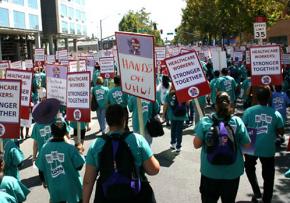SEIU trashes union democracy in California
, a member of SEIU Local 1021, looks at the aftermath of International President Andrew Stern's takeover of the union's California affiliate United Healthcare Workers-West.
AFTER SEEING their union building seized by the Service Employees International Union (SEIU) International office, the ousted leaders of United Healthcare Workers-West (UHW) are seeking to launch a new health care union.
The SEIU takeover of UWH came January 27, capping a year-and-a-half-old battle that began with a rift over how contracts would be negotiated. In particular, former UHW President Sal Rosselli disagreed with SEIU President Andrew Stern over whether UHW should forego certain rights--such as the right to strike or even publicly criticize employers--in order to obtain an employer's blessing to organize its employees.
Rosselli and other UHW leaders challenged Stern, countering that contracts need to be negotiated from a position of strength that flows from rank-and-file militancy and democratic participation.
Now that Stern's operatives have seized physical control of the UHW building, the union's ousted leaders have announced the formation of the National Union of Healthcare Workers (NUHW), an entity that will attempt to regain UHW's bargaining units by running union decertification campaigns.

Predictably, the SEIU International is accusing the new NUHW of trying to undermine existing collective bargaining agreements with the SEIU that had been negotiated by UHW. But the International has only itself to blame for this situation.
For more than a year, Stern has been threatening the very existence of UHW. And just two months after disavowing any alleged attempt to place UHW under trusteeship in response to a May 1, 2008, statement signed by many progressive academics, the International turned around and began trusteeship hearings on the local.
In response, UHW mobilized thousands of members from around the state of California to attend and testify at the hearings, which the members described as a kangaroo court. Most of the charges that SEIU leveled at UWH were recycled from--and actually thrown out of--federal court proceedings.
SEIU claimed that the hearing was fair, since the presiding officer was Ray Marshall, a former U.S. Secretary of Labor. Though Marshall wasn't scheduled to publish his conclusions until early 2009, most progressives in the labor movement concluded that his ruling would not favor of UHW.
In any case, the SEIU International wasn't about to take the chance that Marshall might rule against them. Immediately following the hearings, the International began sending out ballots to SEIU health care workers in California with two options.
Option A favored the implementation of the International's plan to remove UHW's 65,000 long-term care workers and form a statewide long-term care local. Option B was even more drastic. It urged the formation of a statewide health care workers local--both hospital and long-term care workers--a move that would have wiped UHW off the map.
Given these non-choices, it was clear that the election was unfair. This was made all the more apparent by the fact that 120,000 members filed formal complaints challenging it. In the end, less than 8 percent of the 309,000 ballots received were returned. In this small group, the option to create a statewide long-term care local was the clear winner.
The International Executive Board of SEIU took that vote as a mandate. On January 9, the board voted to create that state-wide local. Tellingly, it made this move based not only on the sham election, but also on the authority granted to it by SEIU's constitution, which allows it to conduct mergers and consolidations unilaterally.
Ray Marshall played along with the International. His report on the trusteeship hearings included an ultimatum: UHW must comply with the removal of its 65,000 long-term care workers or face trusteeship.
UHW's responded that it would only allow such a removal after a democratic vote of those members. This was ignored, and the next day, UHW was placed under trusteeship.
It is understandable that the former UHW leadership has decided to form a new union. They tried to develop reform and union democracy within SEIU, but were ousted. In fact, there are other bargaining units and even whole locals that have left SEIU, or have threatened to leave, to get the International to back off.
More generally, a growing number of SEIU members are skeptical that the union's promises that "bigger"--massive statewide mergers--means "better" in terms of contracts. Despite Stern's heavy-handed tactics, rank-and-file activists and members of groups such as SEIU Member Activists for Reform Today will continue to resist this top-down unionism. The struggle for union democracy in SEIU will continue.


